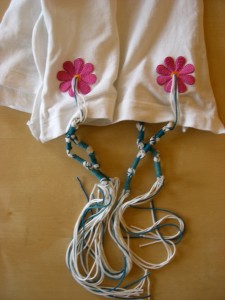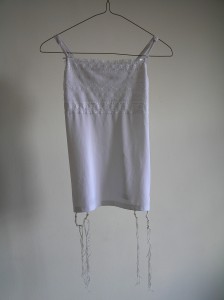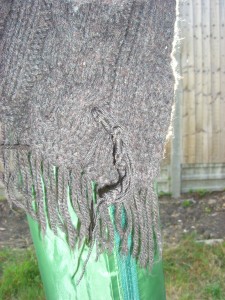Wearing tzitzit under your clothes isn’t just something men do, but commercially-available tallitot katanot are definitely man-shaped. Bring a strappy top and come learn how to make a tallit katan that fits your body. Sewing skills not necessary.
Basically we’re going to go through the steps detailed in Danya’s classic post: take a strappy top, turn it into a four-cornered garment by removing stitches, make holes in it, and attach tzitzit.
(Translation for speakers of American English: strappy top is what you call a tank top.)
We’re assuming that you want to wear tzitzit, and that you’ve got over your “but that’s a MAN’s thing!!!” wibbles. People are welcome to discuss their wibbles, but that’s not the focus of the session, so I’m not providing sources on that here. Email me if you want sources.
Strappy top: fits under girl clothes, and is not a man’s garment.
Now, the Mishnah Berurah (16:1) says that the shoulder parts should be wide, and davka shouldn’t be straps: ויעשה הכתפים של הטלית-קטן רחבים כדי שיהיו נכרים ויהיה עליהם תורת בגד ולא שם רצועות. He seems to be saying that anything with shoulder-straps is not a garment and therefore doesn’t qualify for tzitzit. I rather think that, certainly in women’s clothing, the statements is a garment and has shoulder straps are not mutually exclusive, and therefore it’s probably okay to make a girl tallit katan out of a strappy top.
So, strappy top.
- I don’t believe you can buy wool/linen blend strappy tops, but just in case: don’t buy a wool/linen blend.
- Some say you shouldn’t put tzitzit on cotton or certain types of synthetics; if you’re of that camp, buy a mostly-wool top (Good luck with that. You might have to make one). If you’re not of that camp, go right ahead with your cotton or synthetic top. If you’re not sure, ask your rabbi or your google or read this and make a decision that’s consonant with your other values.
- Some say there’s a minimum size for a tallit katan. Others don’t. Women’s clothes are generally smaller than men’s clothes; compare childrens’ sizes of tallit katan, which apparently hold that it’s all relative to the body size. You might care to find out which way your community holds on the minimum size for a woman’s tallit katan.

Turning into four-cornered garment: slitting the seams 51% up the side.
- The straps don’t count as part of the 51% reckoning.
- Either rip the stitches or just CHOP THEM ALL OFF, WAHEY.
- Optional sewing part: hemming the edges and putting in a few stitches to stop the seam tearing any further.
Reinforcing the corners:
- With sewing, like a buttonhole, to stop the holes ripping open.
- If the holes rip open, it’s still ok to wear, but it’s shvach.
- I find that the armpit part goes yucky long before the corners start ripping, so I tend to skip this step. Then again, if I wore the tzitzis hanging out more often, they’d catch on things, in which case reinforced corners would be a good idea.
- You can also reinforce the corners with awesome things like a certain JTS rabbi does.
Cutting holes:
- They’re supposed to be two etzbaot from each side. 5cm gives you a bit extra to allow for stretching and such.
- There are about a billion squillion explanatory videos, blog posts, photos and websites out there explaining how to do it. Here’s the Jewish Catalog version.
- When pulling halakha off the internet, often a good idea to compare several independent sources and make sure they’re all saying the same thing.
- Remember to say leshem mitzvat tzitzit, that you’re doing this for the purpose of the mitzvah of tzitzit.
Girl Clothing:
- There is a stringency to have the tzitzit be the same colour as the garment, but Ashkenazim (dunno about non-Ashkenazim) don’t bother with it any more. Still, girls’ clothes tend to be colour-co-ordinated, so if you like dyeing things, you might consider it, like this Hadar fellow has.
The order’s important. First make the four corners, then attach the tzitzit. Not the other way round.
On wearing them – depending how you view womanhood and tallit katan and the intersection of same, you may or may not want to be making a bracha when you put the things on. Again, ask your rabbi, ask your google, ask your friends.

